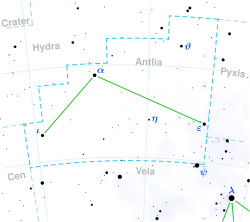Epsilon Antliae
| Observation data Epoch J2000 Equinox J2000 | |
|---|---|
| Constellation | Antlia[1] |
| Right ascension | 09h 29m 14.720s[2] |
| Declination | −35° 57′ 04.81″[2] |
| Apparent magnitude (V) | +4.51[3] |
| Characteristics | |
| Spectral type | K3 IIIa[4] |
| U−B color index | +1.68[5] |
| B−V color index | +1.44[5] |
| Astrometry | |
| Radial velocity (Rv) | +22.2[3] km/s |
| Proper motion (μ) | RA: −24.844 mas/yr[2] Dec.: +5.720 mas/yr[2] |
| Parallax (π) | 4.6349±0.0920 mas[2] |
| Distance | 700 ± 10 ly (216 ± 4 pc) |
| Absolute magnitude (MV) | −2.17[1] |
| Details | |
| Mass | 2.3[6] M☉ |
| Radius | 53[7] R☉ |
| Luminosity | 901[7] L☉ |
| Surface gravity (log g) | 1.86[6] cgs |
| Temperature | 4.348[7] K |
| Metallicity [Fe/H] | −0.14[6] dex |
| Rotational velocity (v sin i) | 3.3[8] km/s |
| Other designations | |
| ε Ant, CD−35 5724, FK5 356, HD 82150, HIP 46515, HR 3765, SAO 200416, PPM 286515[9] | |
| Database references | |
| SIMBAD | data |
Epsilon Antliae is a single[10] star in the southern constellation of Antlia.[1] It is positioned near the western constellation border and forms part of the main asterism.[11] The Bayer designation is Latinized from ε Antliae, and abbreviated Eps Ant or ε Ant, respectively. The apparent visual magnitude of this star is +4.51,[3] which means it is visible to the naked eye at night. From parallax measurements, the distance to this star is approximately 700 light-years (210 parsecs).[2] It is drifting further away from the Sun with a radial velocity of +22 km/s.[3]
The stellar classification of this star is K3 IIIa,[4] where the luminosity class of III indicates that this is an evolved giant star that has exhausted the supply of hydrogen at its core. It has expanded to around 56 times the radius of the Sun and radiates approximately 919 times the Sun's luminosity from its photosphere at an effective temperature of 4,237 K.[2] Photometry measurements during the Hipparcos mission indicate that this star is undergoing periodic luminosity variation by 0.0034 magnitudes over an 11.07941 day cycle.[12]
See also
[edit]References
[edit]- ^ a b c Anderson, E.; Francis, Ch. (2012), "XHIP: An extended hipparcos compilation", Astronomy Letters, 38 (5): 331, arXiv:1108.4971, Bibcode:2012AstL...38..331A, doi:10.1134/S1063773712050015, S2CID 119257644.
- ^ a b c d e f Vallenari, A.; et al. (Gaia collaboration) (2023). "Gaia Data Release 3. Summary of the content and survey properties". Astronomy and Astrophysics. 674: A1. arXiv:2208.00211. Bibcode:2023A&A...674A...1G. doi:10.1051/0004-6361/202243940. S2CID 244398875. Gaia DR3 record for this source at VizieR.
- ^ a b c d Wielen, R.; et al. (1999), "Sixth Catalogue of Fundamental Stars (FK6). Part I. Basic fundamental stars with direct solutions", Veroeffentlichungen des Astronomischen Rechen-Instituts Heidelberg, 35 (35), Astronomisches Rechen-Institut Heidelberg: 1, Bibcode:1999VeARI..35....1W.
- ^ a b Eggleton, P. P.; Tokovinin, A. A. (September 2008). "A catalogue of multiplicity among bright stellar systems". Monthly Notices of the Royal Astronomical Society. 389 (2): 869–879. arXiv:0806.2878. Bibcode:2008MNRAS.389..869E. doi:10.1111/j.1365-2966.2008.13596.x. S2CID 14878976.
- ^ a b Johnson, H. L.; et al. (1966), "UBVRIJKL photometry of the bright stars", Communications of the Lunar and Planetary Laboratory, 4 (99): 99, Bibcode:1966CoLPL...4...99J.
- ^ a b c Khalatyan, A.; Anders, F.; Chiappini, C.; Queiroz, A. B. A.; Nepal, S.; Dal Ponte, M.; Jordi, C.; Guiglion, G.; Valentini, M.; Torralba Elipe, G.; Steinmetz, M.; Pantaleoni-González, M.; Malhotra, S.; Jiménez-Arranz, Ó.; Enke, H.; Casamiquela, L.; Ardèvol, J. (2024). "Transferring spectroscopic stellar labels to 217 million Gaia DR3 XP stars with SHBoost". Astronomy and Astrophysics. 691: A98. arXiv:2407.06963. Bibcode:2024A&A...691A..98K. doi:10.1051/0004-6361/202451427.
- ^ a b c Fetherolf, Tara; Pepper, Joshua; Simpson, Emilie; Kane, Stephen R.; Močnik, Teo; English, John Edward; Antoci, Victoria; Huber, Daniel; Jenkins, Jon M.; Stassun, Keivan; Twicken, Joseph D.; Vanderspek, Roland; Winn, Joshua N. (2023). "Variability Catalog of Stars Observed during the TESS Prime Mission". The Astrophysical Journal Supplement Series. 268 (1): 4. arXiv:2208.11721. Bibcode:2023ApJS..268....4F. doi:10.3847/1538-4365/acdee5.
- ^ De Medeiros, J. R.; Alves, S.; Udry, S.; Andersen, J.; Nordström, B.; Mayor, M. (2014). "A catalog of rotational and radial velocities for evolved stars. V. Southern stars". Astronomy and Astrophysics. 561: A126. arXiv:1312.3474. Bibcode:2014A&A...561A.126D. doi:10.1051/0004-6361/201220762.
- ^ "eps Ant". SIMBAD. Centre de données astronomiques de Strasbourg. Retrieved 2012-06-25.
{{cite web}}: CS1 maint: postscript (link) - ^ Eggleton, P. P.; Tokovinin, A. A. (September 2008), "A catalogue of multiplicity among bright stellar systems", Monthly Notices of the Royal Astronomical Society, 389 (2): 869–879, arXiv:0806.2878, Bibcode:2008MNRAS.389..869E, doi:10.1111/j.1365-2966.2008.13596.x, S2CID 14878976.
- ^ Streicher, Magda (June 2010), "Antlia, the Machine Pneumatique", Monthly Notes of the Astronomical Society of South Africa, 69 (5 and 6): 107–112, Bibcode:2010MNSSA..69..107S.
- ^ Koen, Chris; Eyer, Laurent (March 2002), "New periodic variables from the Hipparcos epoch photometry", Monthly Notices of the Royal Astronomical Society, 331 (1): 45–59, arXiv:astro-ph/0112194, Bibcode:2002MNRAS.331...45K, doi:10.1046/j.1365-8711.2002.05150.x, S2CID 10505995.


 French
French Deutsch
Deutsch